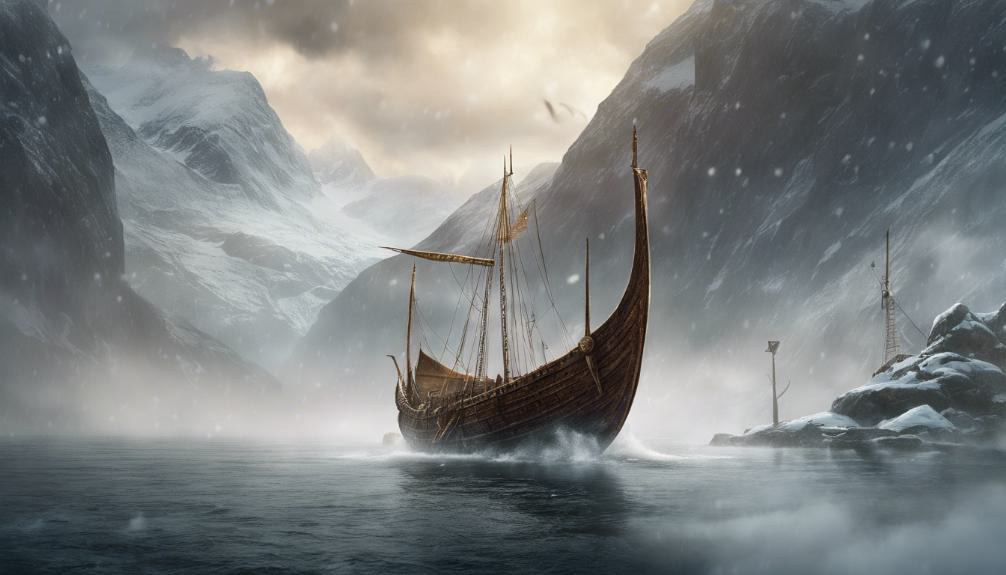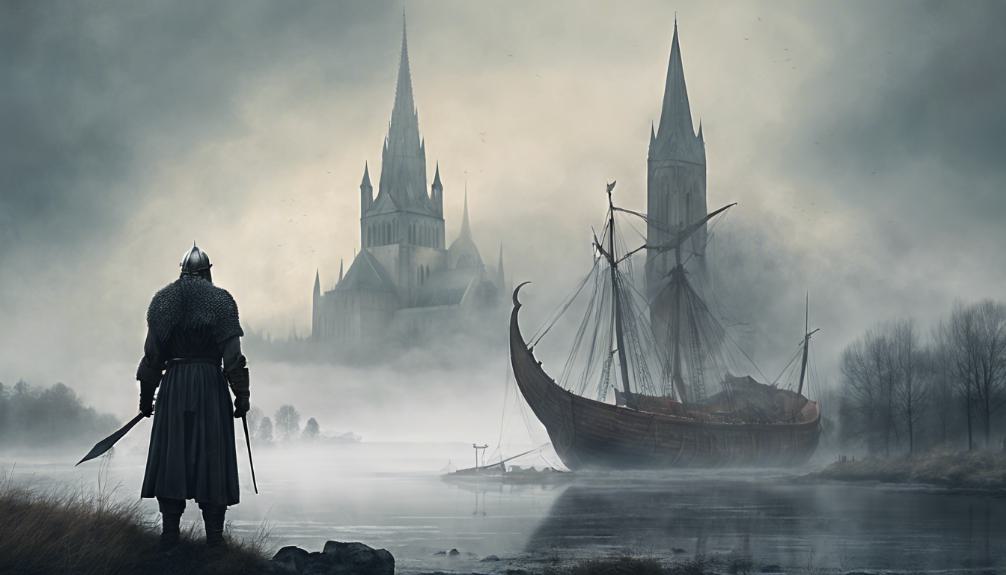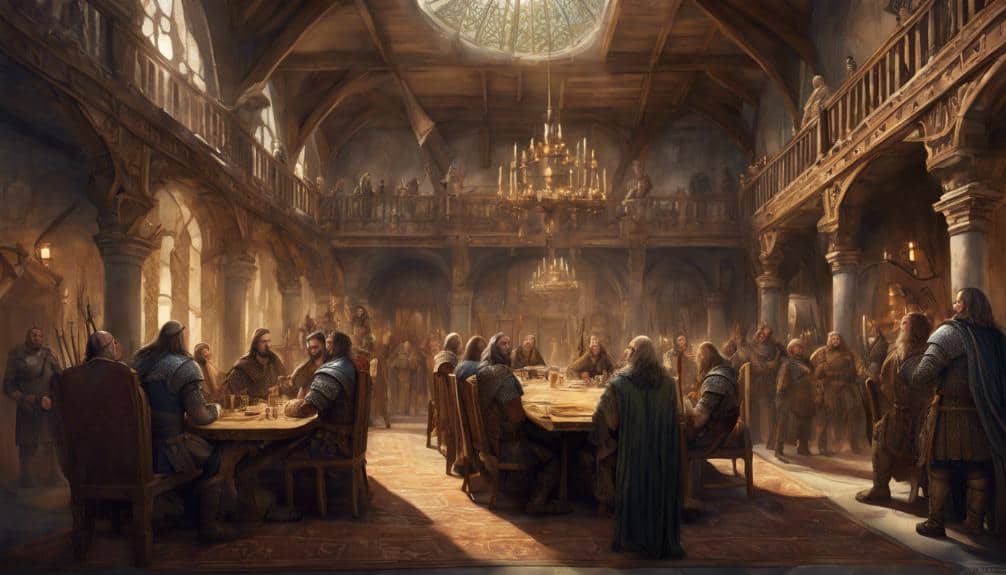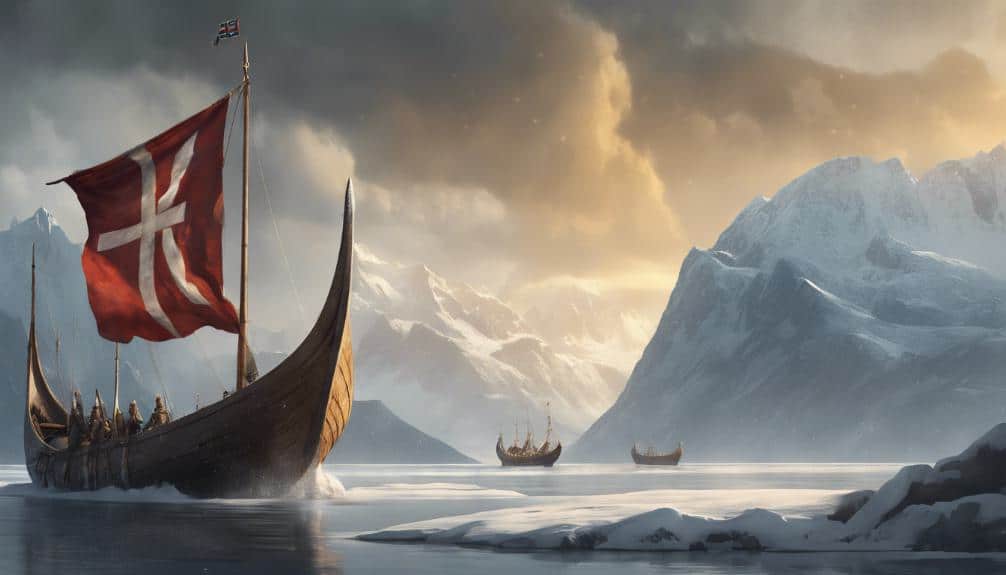In the shadows of Norway’s medieval history, a powerful dynasty emerged in Trøndelag, exerting unparalleled influence over the region.
The Earls of Lade, with their strategically located stronghold, masterfully navigated alliances and rivalries to become the region’s power brokers.
Through a complex web of marriages, diplomacy, and military cooperation, they expanded their reach, shaping the country’s medieval landscape.
But what drove these ambitious patriarchs to position themselves at the epicenter of Norway’s power struggle?
Theirs is a story of calculated strategy, cunning politicking, and a legacy that still resonates in Norway’s cultural and political identity.
Rise of the Lade Dynasty

As the Viking Age dawned, the Lade dynasty began to emerge in the region of Trøndelag, Norway, largely due to the crafty and ambition of its early patriarchs. They cleverly navigated the complex web of alliances and rivalries that characterized the era, gradually building a power base that would eventually propel them to prominence.
The Lade dynasty’s rise was facilitated by their strategic location, which enabled them to control the flow of goods and people through the region. They also leveraged their close relationships with the region’s chieftains and petty kings, forging alliances that would prove vital in their quest for dominance.
As the dynasty grew in power, its leaders became adept at manipulating the regional politics, often playing rival factions against each other to further their own interests. Through a combination of shrewd diplomacy, military might, and calculated marriages, the Lade dynasty established itself as a force to be reckoned with in medieval Norway.
Power Brokers of Trøndelag

By the 10th century, the Lade dynasty had cemented its position as power brokers of Trøndelag, wielding significant influence over the region’s politics and commerce.
As the most prominent family in the region, they controlled the flow of goods and resources, making them essential to the local economy.
Their stronghold, the Lade farm, was strategically located near the mouth of the Nidelva River, allowing them to monitor and regulate trade.
The Lade earls also played a pivotal role in regional governance, often serving as advisors to the Norwegian monarchs.
Their extensive network of alliances and kinship ties enabled them to maintain order and stability in the region.
Through their shrewd business acumen and clever diplomacy, the Lade dynasty managed to maintain their power and influence in Trøndelag, solidifying their position as the region’s de facto rulers.
As the centuries passed, their influence would only continue to grow, shaping the course of Norwegian history.
The Kingmakers’ Strategic Alliances

The Lade earls forged strategic alliances with influential nobles and regional chieftains, carefully cultivated through marriage, diplomacy, and military cooperation.
These alliances enabled them to expand their influence and secure their power base in Trøndelag. By marrying into prominent families, the earls strengthened their ties with other noble houses and acquired valuable connections.
Diplomatic efforts, often facilitated by the Church, allowed them to negotiate advantageous agreements and resolve conflicts peacefully. Military cooperation, meanwhile, provided an added layer of security, as the earls could rely on their allies to provide military support in times of need.
Through these alliances, the Lade earls created a complex web of relationships that helped them maintain their position as power brokers in Norway. They skillfully navigated the intricate landscape of medieval politics, always mindful of the shifting balance of power and the need to adapt their strategies accordingly.
As a result, they were able to consolidate their power and shape the course of Norway’s history.
Shaping Norway’s Medieval History

Through strategic planning and wise decision-making, they exerted significant influence over Norway’s medieval politics, ultimately shaping the country’s trajectory.
The Earls of Lade played a central role in forging alliances, managing power struggles, and advising monarchs, thereby solidifying their position as kingmakers. By utilizing their wealth, military strength, and strategic alliances, they navigated the intricate web of medieval politics, often orchestrating events from behind the scenes.
Their influence extended to the church, where they exerted considerable control over ecclesiastical appointments and policies. This allowed them to further strengthen their power and influence the country’s religious landscape.
Additionally, they played an essential role in promoting trade, commerce, and cultural exchange, which contributed to Norway’s economic growth and cultural development.
Through their insightful leadership and strategic maneuvering, the Earls of Lade left an enduring mark on Norway’s medieval history.
The Lade Legacy in Norway

Seventeen centuries on, their legacy remains palpable in Norway’s modern landscape, where the remnants of their stronghold still whisper tales of their erstwhile power.
The Earls of Lade‘s influence on Norway’s medieval history is undeniable, and their impact continues to shape the country’s cultural and political identity. Today, the region of Trøndelag, where the Earls once held sway, is a thriving hub of Norwegian culture, with the city of Trondheim serving as a proof of the Earls’ lasting legacy.
The region’s rich cultural heritage, from its medieval architecture to its vibrant folk music, is a direct result of the Earls’ patronage and encouragement of the arts. Moreover, the Earls’ role in shaping Norway’s monarchy and system of governance continues to influence the country’s political landscape.
The modern-day Norwegian government, with its constitutional monarchy and parliamentary system, owes a debt of gratitude to the Earls’ innovative and forward-thinking approach to statecraft. Accordingly, the Lade legacy remains an integral part of Norway’s modern identity, a proof to the enduring power of their vision and leadership.










Add Comment